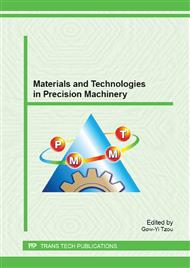[1]
J.A. Rogers, Z. Bao, K. Baldwin, A. Dodabalapur, B. Crone, V.R. Raju, V. Kuck, H. Katz, K. Amundson, Paperlike electronic displays: large-area rubberstamped plastic sheets of electronics and microencapsulated electrophoretic inks, Proc. Natl. Acad. Sci. 98 (2001).
DOI: 10.1073/pnas.091588098
Google Scholar
[2]
N.D. Robinson, L. Edman, M. Chhowalla, Graphene electrodes for organic metal-free light-emitting devices, Phys. Scr. T146 (2012) 014023-014032.
DOI: 10.1088/0031-8949/2012/t146/014023
Google Scholar
[3]
J. Han, B.J. Seo, S.K. Kim, Z. Hua, H.R. Fetterman, Single-chip integrated electrooptic polymer photonic RF phase shifter array, Lighwave Technol. 21 (2003) 3257–3261.
DOI: 10.1109/jlt.2003.819801
Google Scholar
[4]
C.C. Wu, C.F. Yang, Y.C. Chen, C.Y. Huang, C.J. Huang, Fabricate circular polarization antenna on PEI/BSTZ composite substrate for the application of UHF-RFID reader, J. Electrochem. Soc. 156 (2009) G197–G200.
DOI: 10.1149/1.3236636
Google Scholar
[5]
J. Lu, C.P. Wong, Recent advances in high-k nanocomposite materials for embedded capacitor applications, IEEE Trans. Dielectr. Electr. Insul. 15 (2008) 1322-1328.
DOI: 10.1109/tdei.2008.4656240
Google Scholar
[6]
D.H. Kuo, C.C. Chang, T.Y. Su, W.K. Wang, and B.Y. Lin, Dielectric behaviors of multi-doped BaTiO3/epoxy composites. J. Euro. Ceram. Soc. 21 (2001) 1171-1177.
DOI: 10.1016/s0955-2219(00)00327-7
Google Scholar
[7]
C.M. Chang, M.C. Lin, W.S. Jou, T.L. Wu, W.H. Cheng, New package scheme of a 2. 5Gb/s plastic transceiver module employing multiwall carbon nanotubes of low electromagntic interference. IEEE J Sel Topics Quantum Electron. 12 (2006) 1025-1031.
DOI: 10.1109/jstqe.2006.879534
Google Scholar
[8]
C.M. Chang, J.C. Chiu, Y.F. Lan, J.W. Lin, C.Y. Yeh, W.S. Jou, High electromagnic shielding of a 2. 5Gb plastic transceiver modules using dispersive multiwall carbon nanotubes. J Lightwave Technol, 26 (2008) 1256-1562.
DOI: 10.1109/jlt.2008.917054
Google Scholar
[9]
C. Highstrete, E.A. Shaner, M. Lee, F.E. Jones, P.M. Dentinger, A. Alec Talin, Microwave dissipation in arrays of single-wall carbon nanotubes. Appl. Phys. Lett. 89 (2006)173105-173107.
DOI: 10.1063/1.2364061
Google Scholar
[10]
Y.H. Hu, Progress on production technology and applications of bamboo carbon and bamboo distillate. Chem. Ind. For Prod. 22 (2002) 79-83.
Google Scholar
[11]
G.S. Hwang, H.Y. Yu, A. Toba, Effects of carbonization temperatures in an earthen kiln on the true density and electric resistivity of Makino bamboo charcoal. Taiwan J. For Sci. 19 (2004) 237-245.
Google Scholar
[12]
Q.H. Zhang, S.X. Jiang, J.B. Zhou,. Bamboo charcoal technologies, properties, uses and economics. INBAR final project report. Nanjing, China: Bamboo Engineering Research Center, Forestry Univ. (2004).
Google Scholar
[13]
W.B. Zhang, Y.K. Hua, L. M Ye., A study on mechanism of electric conduction of bamboo charcoal. J. Nanjing For Univ. (Nat. Sci. Ed. ), 26 (2002) 47-50.
Google Scholar
[14]
J.G. Hyun, S. Lee, S.D. Cho, and K.W. Paik, Frequency and temperature dependence of dielectric constant of epoxy/BaTiO3 composite embedded capacitor films (ECFs) for organic substrate, Electronic Components and Technology Conference. (2005).
DOI: 10.1109/ectc.2005.1441429
Google Scholar
[15]
K.W. Paik, S. Cho, and J.G. Hyun, Novel epoxy/BaTiO3 composite embedded capacitor films embedded in organic substrate, International IEEE Conference on Asian Green Electronics (AGEC), (2004) 68-73.
DOI: 10.1109/agec.2004.1290869
Google Scholar
[16]
S. O'Reilly, M. Duffy, T. Ott, T. O'Donnell, P. McCloskey, and C. O'Mathuna, Characterization of embedded filters in advanced printed wiring boards, Microelectronics Reliability, 41 (2001) 781-788.
DOI: 10.1016/s0026-2714(01)00043-9
Google Scholar
[17]
S.D. Cho, J.Y. Lee, J.G. Hyun, K.W. Paik, Study on epoxy/BaTiO3 composite embedded capacitor films (ECFs) for organic substrate applications. Mate. Sci. Eng. B 110 (2004) 233–239.
DOI: 10.1016/j.mseb.2004.01.022
Google Scholar


